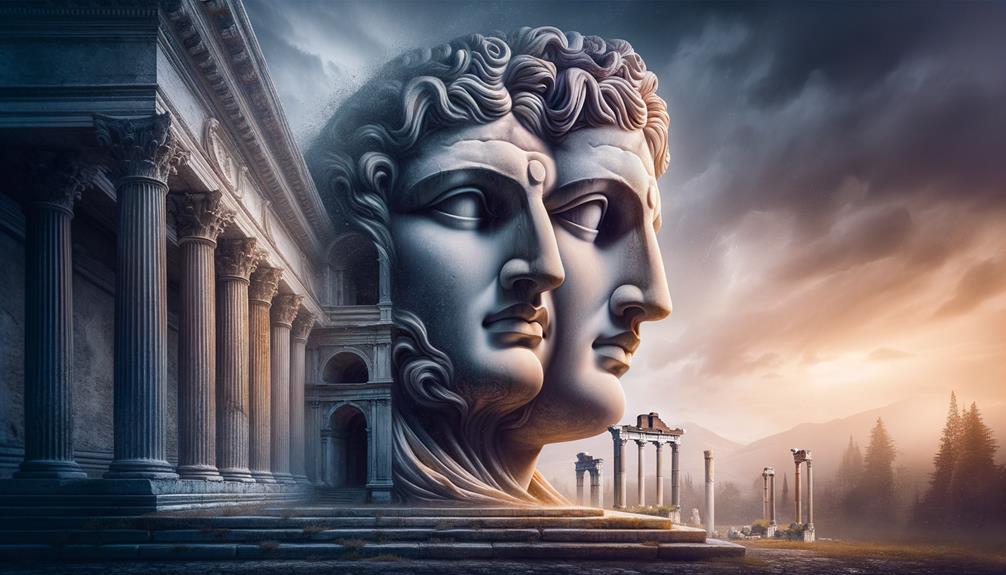Much like Odysseus navigating life's crossroads, I ponder the intriguing figure of Janus, the dual-faced Roman deity overseeing transitions. Embodying both retrospective wisdom and forward vision, Janus stands guard at pivotal moments. This duality mirrors the human experience – honoring the past while embracing the future. Janus's presence in ancient rituals and temples reflects an understanding of cyclical renewal. But what deeper insights do his twin visages offer about our journeys through change?
Who Is Janus?
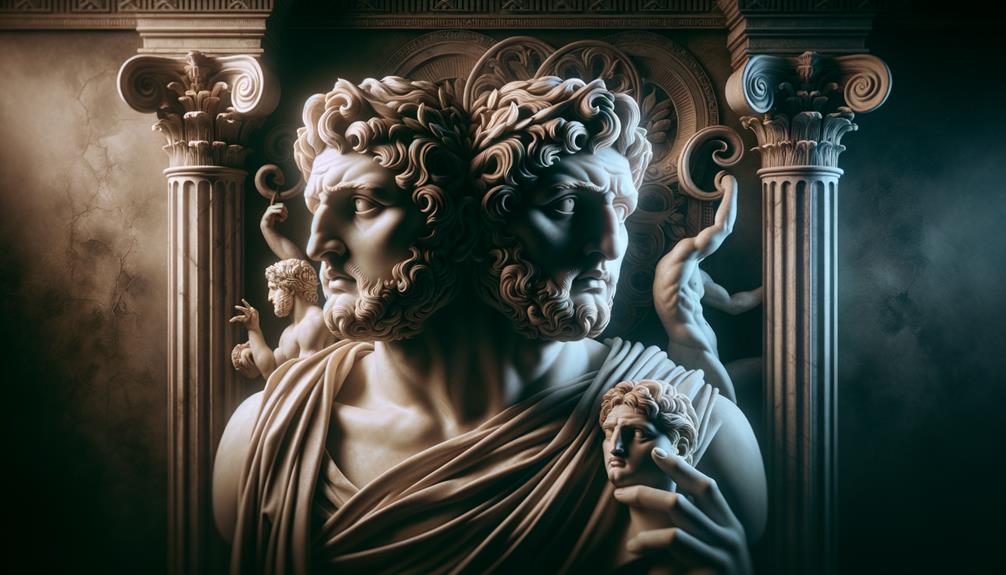
Janus, the two-faced Roman deity, guards life's transitions, his visages representing the past and future. As the god of beginnings and endings, he oversees pivotal moments like weddings, births, and deaths. His dual perspective symbolizes the delicate equilibrium between what was and what's to come.
In Roman mythology, Janus holds the metaphorical key to change. His presence reminds us that new paths emerge from old ones, and endings pave the way for fresh starts. January, named after him, bridges the previous year's remnants with the new year's potential.
Like Janus gazing forward and back, we navigate myriad passages in life. Janus guides us through these crossroads, his watchful eyes leading the archetypal journey we all undertake.
Significance of Two Faces
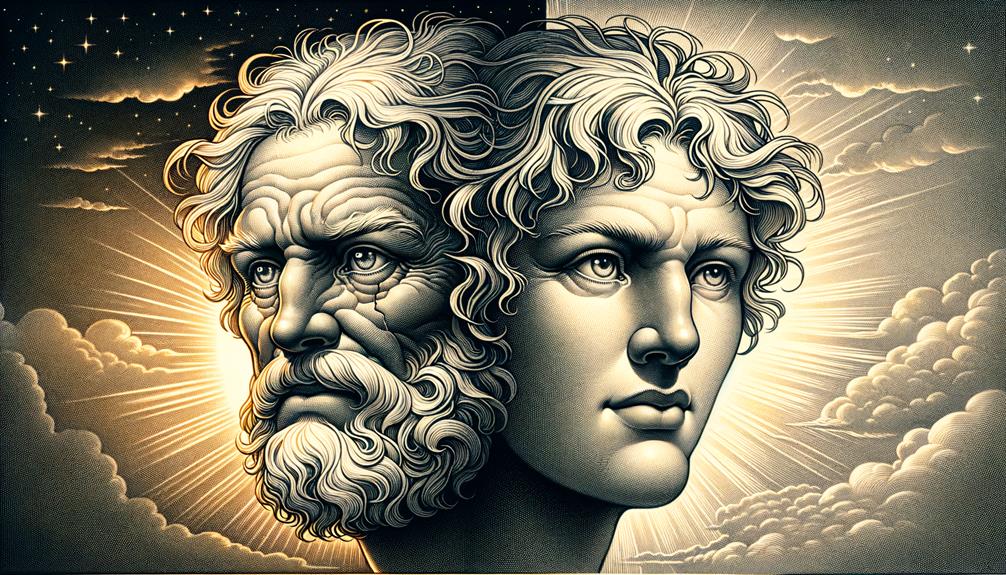
The two faces represent the wisdom to navigate life's ebb and flow. Like Janus, the Roman god, one face reflects on the past while the other peers ahead. This balance isn't superficial; it's the equilibrium to manage old and new. Janus' dual perspective makes him the gatekeeper of change, the usher of beginnings, and the guide through transitions. His two faces symbolize the philosophical doorways we encounter daily.
| Reminiscing | Anticipating |
|---|---|
| Looks Backward | Gazes Forward |
| Closure's Guardian | New Start's Herald |
| Invites Reflection | Sparks Vision |
| Oversees Endings | Facilitates Beginnings |
| Represents Wisdom | Signifies Insight |
Under Janus' tutelage, change feels less daunting. His contrasting faces remind us that while transition is inescapable, it's also surmountable – every conclusion making space for a fresh start. In his balanced duality lies an ageless metaphor for foresight and adaptability.
Janus in Roman Rituals

In ancient Rome, invoking Janus marked the threshold of new beginnings and transformations during rituals. As the deity of doorways, Janus symbolized transitions from one state to another, guiding changes. Roman ceremonies frequently commenced with prayers to Janus, seeking his favor as they embarked on new ventures.
Sacred rites dedicated to him emphasized his significance:
- The New Year: Romans honored Janus during the Kalends festival, marking the first day of the year. His dual faces represented the shift from past to future.
- Monthly and Daily Rituals: Janus was invoked at each month and day's start, symbolizing the continuous cycle of beginnings and endings.
- Seasonal Ceremonies: Janus played a vital role in various seasonal festivals, guiding the community through nature's and life's cyclical transformations.
Temples dedicated to Janus served as pivotal centers for these sacred ceremonies. His doorway symbolism permeated Roman culture, reinforcing the notion that every new beginning is both an ending and a start. Through these rituals, Janus guided Romans on their transformative journeys, embodying the archetypal guardian of change.
Temples Dedicated to Janus
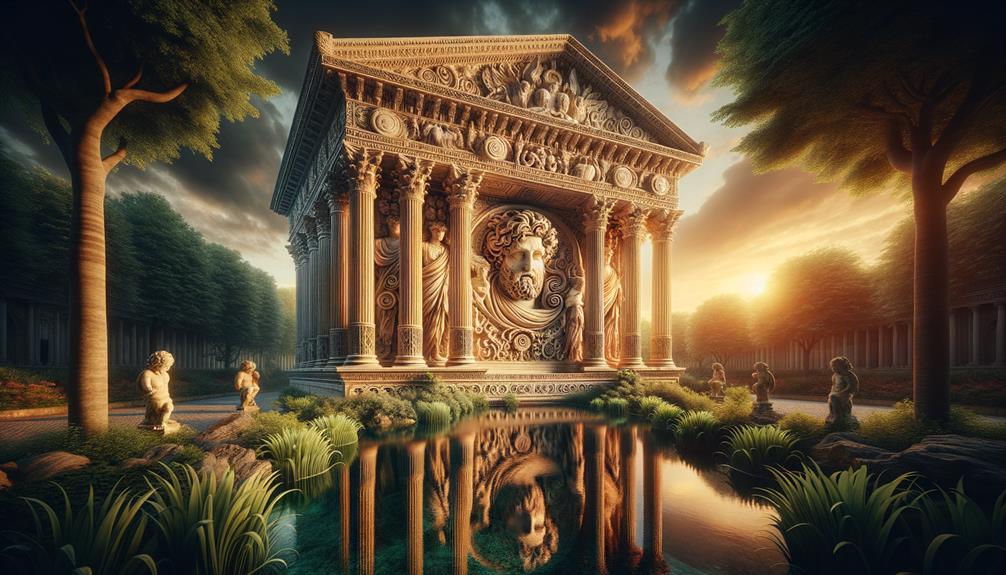
In ancient Rome, Janus' temples stood as sacred thresholds where rituals honored life's transformations. The Ianus Geminus shrine held particular significance, with doors open during wartime and closed during peace, reflecting the duality Janus embodied.
Romans gathered at these hallowed spaces to perform ceremonies as they embarked on new personal or communal ventures, seeking Janus' blessings. More than architectural wonders, these temples were the beating heart of Roman worship, where the essence of beginnings and metamorphoses was revered.
Through the arches of Janus' temples, worshippers felt connected to the divine force governing change. Each ceremony marked a heroic passage through life's thresholds under Janus' watchful gaze. Pillars of stability and transition, these temples ensured every transformation, serene or tumultuous, received its due reverence.
The Roman people treated Janus' temples as sacred gateways. Whether starting a war or ushering in peace, these sites guided them through life's pivotal moments with rituals honoring the god of beginnings. The architecture embodied Janus' eternal watch over all journeys and turning points.
Janus's Legacy
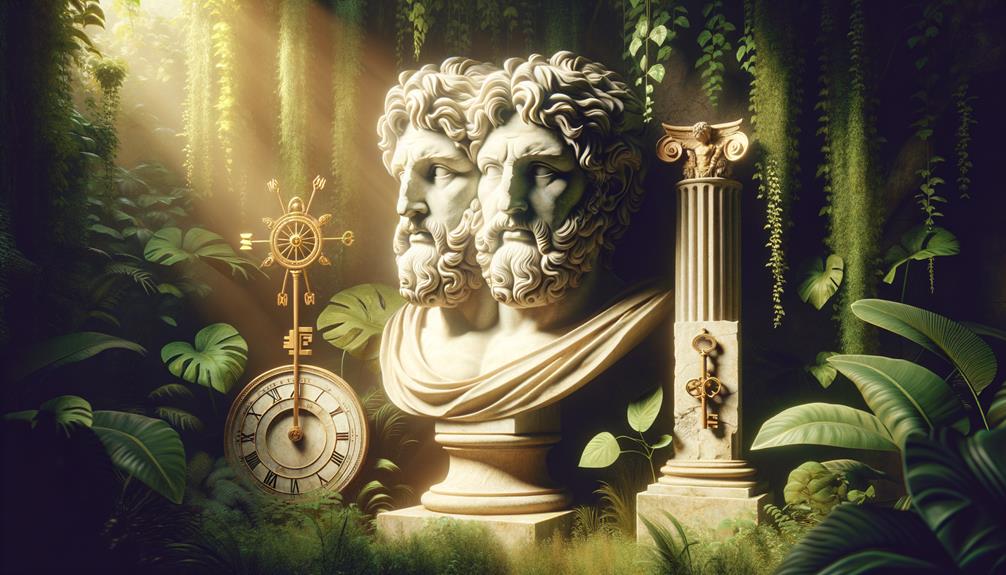
Janus's influence continues to captivate, representing the delicate balance between past and future through his two-faced visage. The Roman deity of transitions, Janus, guards the crossroads of time itself, embodying beginnings and endings within ancient Roman beliefs.
Janus's essence pervades our lives profoundly. His enduring impact manifests through:
- Gatekeeper Role: Janus safeguards thresholds, both physical and symbolic. He stands watch at heavenly and earthly entryways, ensuring safe passage into new phases.
- Time's Personification: January bears his name, cementing Janus as the eternal herald of fresh starts as we transition from one year to the next.
- Ritual Invocations: Ancient Romans summoned Janus at pivotal milestones—weddings, births, city foundings—marking life's monumental transitions.
Janus's duality reminds us that every conclusion seeds a new beginning on the horizon.
Frequently Asked Questions
Who Is the Greek God of Transition?
Greek mythology didn't designate a specific deity to oversee transitions and gateways like Janus in Roman tales. Instead, such roles were dispersed among various gods and heroes. There was no direct "god of change" in their pantheon.
What Do the Two Faces of Janus Represent?
The two faces of Janus symbolize life's perpetual cycle – one side reflecting on past experiences, the other anticipating future prospects. This duality steers me through endings and new beginnings.
How Was Janus Worshiped?
The dawn signaled Romans to invoke Janus, the deity heralding beginnings. As months commenced and the year opened, festivities honored him on January 9th at sacred temples and ceremonial gateways, marking transitions. His worship centered around pivotal moments of change.
What Are the Signs of Janus God?
Janus, the ancient Roman deity overseeing beginnings and endings, is represented by a two-faced visage gazing back and forth. This imagery symbolizes his role as the guardian of transitions. He also carries a key, representing his oversight of doorways and passages. The inclusion of Janus on ancient coins and the naming of January after him cements his eternal position as the protector of change.

